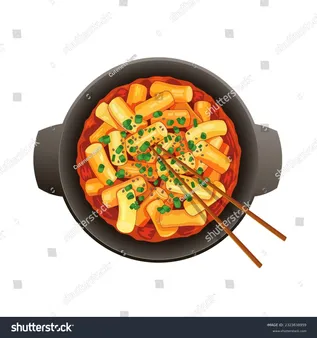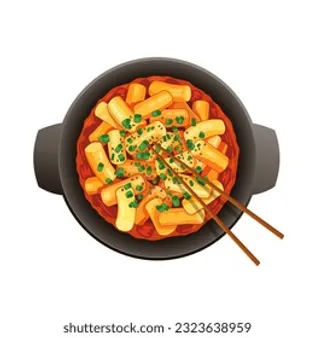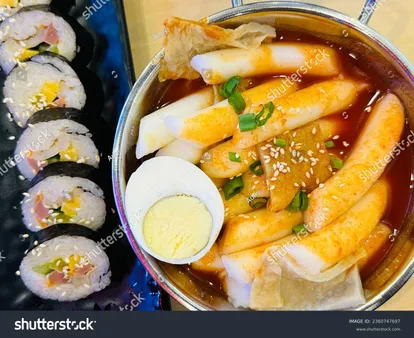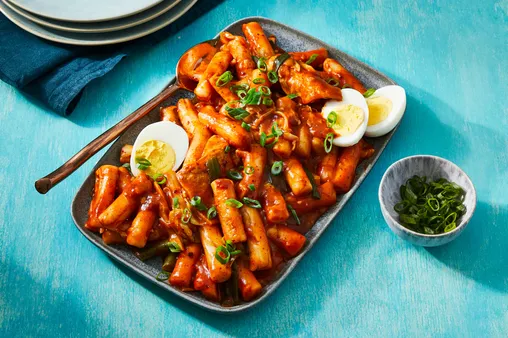Table of Contents
Welcome to Tauhuichiban, where we delve into The art and science of making Korean rice cakes. Tteok, as they are traditionally known, are a culinary marvel that embodies the rich cultural heritage of Korea. Join us on this gastronomic journey as we explore the intricate techniques and precise measurements that transform humble ingredients into delectable treats. From sourcing the finest glutinous rice to mastering the delicate art of steaming and pounding, we'll guide you through every step of the rice cake-making process. Whether you're a seasoned pro or a curious novice, prepare to be captivated by the artistry and scientific precision that define the world of Korean rice cakes.

The Art and Science of Making Korean Rice Cakes: A Culinary Masterclass
I. The Art of Korean Rice Cake Making
The art of Korean rice cake making is a centuries-old tradition that has been passed down from generation to generation. Rice cakes, known as tteok in Korean, are an essential part of Korean cuisine and are enjoyed by people of all ages. They are made from glutinous rice flour and can be steamed, boiled, fried, or grilled. Tteok can be filled with a variety of ingredients, such as red bean paste, sesame seeds, or vegetables. They can also be shaped into different forms, such as balls, squares, or cylinders.
The process of making tteok is labor-intensive, but it is also very rewarding. The first step is to soak the glutinous rice overnight. The next day, the rice is ground into a fine powder. The powder is then mixed with water and steamed until it forms a sticky dough. The dough is then kneaded and shaped into the desired form. The tteok can then be cooked by steaming, boiling, frying, or grilling.
Tteok is a versatile food that can be enjoyed in many different ways. It can be eaten as a snack, a side dish, or a main course. Tteok can also be used in a variety of dishes, such as soups, stews, and stir-fries. Korean cuisine is renowned for its bold flavors and diverse ingredients, and tteok is no exception. These chewy rice cakes can be found in both savory and sweet dishes, adding a unique texture and flavor to every meal.
If you are interested in learning more about the art of Korean rice cake making, there are many resources available online and in libraries. You can also find tteok in most Korean grocery stores. With a little practice, you can make delicious tteok at home.
Type of Tteok | Description |
|---|---|
lgi Tteok | A steamed rice cake made with glutinous rice flour and water. It is often filled with red bean paste or sesame seeds. |
Injeolmi Tteok | A steamed rice cake made with glutinous rice flour and roasted soybean powder. It is often coated in sugar or honey. |
Songpyeon | A steamed rice cake made with glutinous rice flour and filled with sweet red bean paste. It is often shaped into a half-moon shape. |
Gyeongdan | A boiled rice cake made with glutinous rice flour and filled with sweet red bean paste. It is often shaped into a ball. |
Tteokbokki | A stir-fried rice cake made with glutinous rice flour and gochujang (Korean chili paste). It is often served with vegetables and meat. |
Tteok is a delicious and versatile food that can be enjoyed in many different ways. Whether you are a seasoned pro or a complete novice, there is sure to be a tteok recipe that you will love.
Here are some tips for making tteok at home:
- Use high-quality glutinous rice flour. This will ensure that your tteok is chewy and sticky.
- Soak the rice overnight before grinding it. This will help to soften the rice and make it easier to grind.
- Knead the dough until it is smooth and elastic. This will help to prevent the tteok from breaking when it is cooked.
- Cook the tteok according to the recipe instructions. Overcooking or undercooking the tteok can result in a tough or mushy texture.
With a little practice, you can make delicious tteok at home. So what are you waiting for? Give it a try!
In addition to the tips above, here are some additional resources that you may find helpful:
I hope this article has been helpful. If you have any questions, please feel free to leave a comment below.

The Art of Korean Rice Cake Making
II. The Science Behind Korean Rice Cakes
The science behind Korean rice cakes is fascinating. The process of making rice cakes is called tteok in Korean, and it involves a combination of art and science.
- The first step in making rice cakes is to soak the rice in water for several hours. This helps to soften the rice and make it easier to grind.
- Once the rice is soaked, it is ground into a fine paste.
- The rice paste is then mixed with water and steamed until it becomes a sticky dough.
- The dough can then be shaped into different forms, such as balls, squares, or cylinders.
- The rice cakes are then boiled, fried, or steamed until they are cooked through.
The type of rice used, the water ratio, and the cooking method all affect the texture and flavor of the rice cakes. For example, glutinous rice produces a softer rice cake, while non-glutinous rice produces a firmer rice cake.
The water ratio determines the chewiness of the rice cake. A higher water ratio results in a softer, chewier rice cake, while a lower water ratio results in a firmer, less chewy rice cake. The use of glutinous or non glutinous also dictates the firmness and chewiness of the tteok.
The cooking method also affects the texture and flavor of the rice cakes. Boiling produces a soft, tender rice cake, while frying produces a crispy, golden brown rice cake. Steaming produces a soft, chewy rice cake with a slightly sticky texture.
Rice cakes are a versatile food that can be eaten in many different ways. They can be served as a main course, a side dish, or a dessert. They can also be used in soups, stews, and other dishes.
Type of Rice Cake | Texture | Flavor | Cooking Method |
|---|---|---|---|
Injeolmi | Soft and chewy | Slightly sweet | Steamed |
Songpyeon | Chewy and sticky | Sweet or savory | Boiled |
Gyeongdan | Crispy and golden brown | Savory | Fried |
lgi | Soft and tender | Mild | Boiled |
Rice cakes are a delicious and nutritious food that is enjoyed by people of all ages. They are a good source of carbohydrates, protein, and fiber. They are also low in fat and cholesterol.
If you are interested in trying Korean rice cakes, there are many different ways to find them. You can find them in Korean grocery stores, online retailers, and even some supermarkets.
Related Articles | Links |
|---|---|
The history of Korean rice cakes | https://tauhuichiban.com.vn/the-history-and-evolution-of-korean-rice-cakes/ |
The different types of Korean rice cakes | https://tauhuichiban.com.vn/the-varieties-and-flavors-of-korean-side-dishes-and-soups/ |
Korean rice cake recipes | https://tauhuichiban.com.vn/the-fun-and-easy-korean-recipes-for-kids/ |

The Science Behind Korean Rice Cakes
III. Traditional Korean Rice Cake Recipes
Korean rice cakes, known as tteok, are delightful treats that hold a special place in Korean cuisine. These versatile delicacies can take various forms, textures, and flavors, each with its unique significance in Korean culture. From the ubiquitous white tteok to the colorful and chewy songpyeon, the world of Korean rice cakes is a vibrant tapestry of taste and tradition.
Explore our collection of traditional Korean rice cake recipes and discover the intricate artistry of this cherished culinary tradition. Immerse yourself in the flavors and textures that have captivated Koreans for centuries, and bring the joy of tteok into your own kitchen.
Name | Description |
lgi Tteok | Steamed rice cakes with a delicate, chewy texture and a slightly sweet flavor. |
Injeolmi | Chewy rice cakes made with roasted soybean powder, offering a nutty and slightly sweet taste. |
Songpyeon | Half-moon shaped rice cakes filled with sweet fillings such as sesame seeds, honey, or red bean paste. |
IV. Essential Ingredients in Korean Rice Cakes
The foundation of Korean rice cakes lies in a few key ingredients:
- Glutinous rice flour: This special type of rice flour gives tteok its characteristic sticky and chewy texture.
- Water: The amount of water used determines the softness and firmness of the rice cakes.
- Salt: A touch of salt enhances the flavor and balances the sweetness of fillings.
- Additional ingredients: Depending on the type of tteok, various ingredients like beans, nuts, or vegetables may be added for flavor and color.
With these essential ingredients, the possibilities for creating diverse and delectable rice cakes are endless.
V. Step-by-Step Guide to Making Rice Cakes
Making Korean rice cakes at home is a rewarding experience that combines precision and creativity. Follow these steps to craft your own delicious tteok:
- Soak the glutinous rice flour: Wash the flour and soak it in water for several hours or overnight to soften it.
- Grind the soaked rice: Use a traditional stone mill or a food processor to grind the soaked rice into a fine powder.
- Mix the dough: Combine the rice powder with water and salt to form a smooth and elastic dough.
- Shape the rice cakes: Divide the dough into portions and shape them according to the desired type of tteok, such as cylinders, squares, or balls.
- Cook the rice cakes: Depending on the type of tteok, you can steam, boil, or pan-fry them.
With patience and practice, you'll master the art of making authentic and flavorful Korean rice cakes.
VI. Korean Rice Cake Variations
The world of Korean rice cakes is vast and varied, with each region boasting its unique specialties:
- Gangwon-do: Known for its spicy tteokbokki, a stir-fried rice cake dish with a fiery sauce.
- Jeolla-do: Famous for its songpyeon, colorful and intricately shaped half-moon rice cakes.
- Gyeongsang-do: Produces flavorful haemul tteok, seafood rice cakes made with squid, shrimp, and vegetables.
Venture beyond these regional variations and explore the countless other types of Korean rice cakes that await your discovery.
VII. The Art of Shaping and Serving Rice Cakes
Shaping and serving Korean rice cakes is a form of culinary artistry. Each type of tteok has its unique presentation and symbolism:
- lgi tteok: Steamed cylindrical rice cakes arranged vertically in a bowl, representing longevity and good luck.
- Songpyeon: Half-moon shaped rice cakes filled with sweet fillings, often served during the Chuk holiday.
- Injeolmi: Chewy rice cakes coated in roasted soybean powder, served as a dessert or snack.
The presentation of rice cakes plays a vital role in Korean cuisine, adding an aesthetic touch to every occasion.

Traditional Korean Rice Cake Recipes
VIII. Modern Innovations in Korean Rice Cake Making
Korean rice cakes, known as tteok, hold a special place in Korean cuisine. They come in various shapes, sizes, and colors, each with its own unique texture and flavor. Recently, there has been a surge of modern innovations in Korean rice cake making, as chefs and food enthusiasts experiment with new ingredients and techniques to create novel and exciting variations of this traditional delicacy. One notable innovation is the use of alternative grains and flours. Traditional Korean rice cakes are typically made with glutinous rice flour, but modern chefs are now experimenting with other grains such as barley, brown rice, and quinoa. These alternative grains add new flavors and textures to rice cakes, making them more versatile and nutritious.
- How to Make Authentic Chinese Dumplings
- The History and Culture of Chinese Tea
- The Best Chinese Restaurants in Your City
Another modern innovation is the incorporation of non-traditional ingredients into rice cakes. Chefs are now adding fruits, vegetables, herbs, and spices to create rice cakes with unique and complex flavor profiles. For example, some chefs are using matcha powder to create green tea rice cakes, while others are using kimchi to create spicy rice cakes. These new ingredients add a touch of modernity to traditional rice cakes, making them more appealing to a wider audience.
In addition to experimenting with ingredients, modern chefs are also exploring new techniques for making rice cakes. One popular technique is to use a pressure cooker to steam rice cakes, which results in a moister and more delicate texture. Another technique is to use a dehydrator to dry rice cakes, which creates a crispy and crunchy texture. These new techniques allow chefs to create rice cakes with textures that were not possible using traditional methods.
- The Health Benefits of Chinese Herbs and Spices
- The Differences Between Regional Cuisines in China
The modern innovations in Korean rice cake making are not only expanding the culinary possibilities of this traditional dish but also making it more accessible to a wider audience. By using alternative ingredients and techniques, chefs are creating rice cakes that are more flavorful, nutritious, and visually appealing. As a result, Korean rice cakes are becoming increasingly popular both in Korea and around the world.

Modern Innovations in Korean Rice Cake Making
IX. Conclusion
The art and science of making Korean rice cakes is a culinary journey that rewards patience and passion. By understanding the essential ingredients, following the step-by-step guide, and exploring the many variations, you can master the craft of creating perfect tteok. Whether you prefer the chewy texture of chapssal tteok or the delicate sweetness of songpyeon, the possibilities are endless. Embrace the artistry of shaping and serving these delightful treats, and share the joy of Korean rice cakes with your loved ones. As you embark on this culinary adventure, remember that practice makes perfect, and with each batch you create, you will refine your skills and deepen your appreciation for the art of Korean rice cake making.